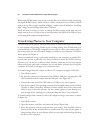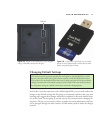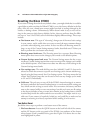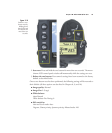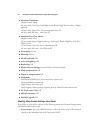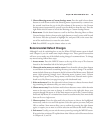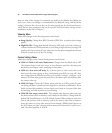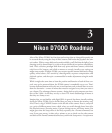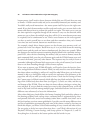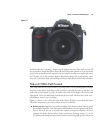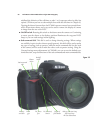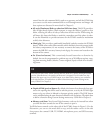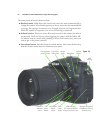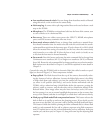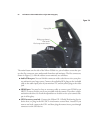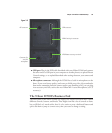button presses (you’ll need to choose between which of the two SD card slots you want
to format—if both contain cards) and you’ve successfully formatted your memory card.
You didn’t really need instructions—the menu system itself led you to the right com-
mand. If you don’t format another card for weeks and weeks, you can come back to the
menus and discover how to perform the task all over again. The main cost to you was
the time required to negotiate through all the menus to carry out the function; while
menus are easy to learn, the multiple steps they call for (10 or more button presses may
be required) can be cumbersome to use. Direct access buttons are the exact opposite:
you have to teach yourself how to use them, and then remember what you’ve learned
over time, but once learned, buttons are much faster to use.
For example, simple direct button presses can also format your memory card, as I
pointed out in the last chapter. Recall how easy it is to just hold down the metering
mode button and the trash can button simultaneously for about two seconds. When
the characters For and the exposures remaining displays blink in the viewfinder and top-
panel LCD, select the slot containing the memory card you want to format (rotate the
main command dial), press the pair of buttons again, and the D7000 formats your card.
To cancel the format, press any other button. The sequence may be tricky to learn or
remember (although red Format labels appear next to the pair of buttons), but it’s much
faster to use than threading through a series of menu options.
If you want to operate your D7000 efficiently, you’ll need to learn the location, func-
tion, and application of all these controls. What you really need is a street-level roadmap
that shows where everything is, and how it’s used. But what Nikon gives you in the user’s
manual is akin to a world globe with an overall view and many cross-references to the
pages that will tell you what you really need to know. Check out the Getting to Know
the Camera pages in Nikon’s manual, which offer four tiny black-and-white line draw-
ings of the camera body that show front (see Figure 3.1), back, two sides, and the top
and bottom of the D7000. There are about six dozen callouts pointing to various but-
tons and dials. If you can find the control you want in this cramped layout, you’ll still
need to flip back and forth among multiple pages (individual buttons can have several
different cross-references!) to locate the information.
Most other third-party books follow this format, featuring black-and-white photos or
line drawings of front, back, and top views, and many labels. I originated the up-close-
and-personal, full-color, street-level roadmap (rather than a satellite view) that I use in
this book and my previous camera guidebooks. I provide you with many different views
and lots of explanation accompanying each zone of the camera, so that by the time you
finish this chapter, you’ll have a basic understanding of every control and what it does.
I’m not going to delve into menu functions here—you’ll find a discussion of your
Playback, Shooting, Custom Settings, and Setup options in Chapters 8, 9, and 10.
Everything here is devoted to the button pusher and dial twirler in you.
David Busch’s Nikon D7000 Guide to Digital SLR Photography48



